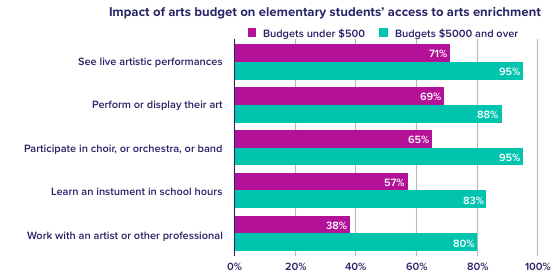Does Ontario provide equitable access to arts education?
Schools with lower parental education and lower incomes less likely to have access to learning opportunities in the arts
New data from People for Education – based on survey results from more than 1200 Ontario elementary and secondary schools – show that, despite the widely recognized importance of arts education, equitable access to arts programs and resources is an ongoing challenge for Ontario’s schools.
While 46% of elementary schools have a specialist music teacher, either full- or part-time, up from 41% last year, it is still well below the 58% of schools reporting music teachers in 1998.
Arts Budgets: Size matters
According to People for Education’s new report, schools’ arts budgets range from less than $500 to $100,000.

Students in elementary schools with budgets over $5000 are more likely to have the opportunity to see live performances, display their art, participate in choir or band, learn an instrument, or work with an artist.
Using data from EQAO surveys, the researchers also found that grade three and six students from schools with lower arts budgets were more likely to say they “never” participate in art, music, or drama activities outside of the school day. Fundraising has an impact as well. Both elementary and secondary schools that report fundraising specifically for the arts are much more likely to report arts budgets of $5000 or more.
The impact of demographics on students’ access to the arts
Data from Statistics Canada and the Ministry of Education, when compared with schools in the sample, show that schools with higher rates of poverty raise less money per school, less money per student, and less money specifically for the arts, as compared to schools with lower rates of poverty.
In addition, elementary schools with higher proportions of parents with university degrees are ten times more likely to have an arts budget of $5000 or more, and twice as likely to have a music teacher, compared to those with lower levels of parental education. These differences hold even when the data is controlled for region (urban vs. rural) and school size; and the pattern extends beyond music to other arts specialists.
The urban-rural divide
“Our school is a small country school with only 8 classrooms. Our teaching staff allotment doesn’t afford us the opportunity to have specialist teachers.”
Elementary school, Lambton-Kent DSB
Schools in rural areas face more challenges than their urban counterparts in providing arts education.  This year’s survey results show:
This year’s survey results show:
- Urban elementary schools are three times more likely than rural schools to have a budget of $5000 or more.
- Urban schools are more likely to have specialist arts teachers, and those teachers are more likely to have advanced qualifications.
